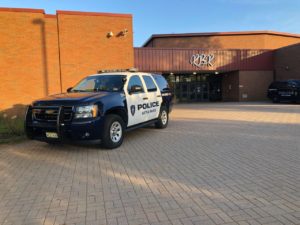By Christina Johnson
LITTLE SILVER – Police and administrators offered parents a glimpse into Red Bank Regional High School’s security plan Tuesday night, in a talk that revealed a history of preparation and sobering facts about how the school community has been forced to adapt to the nationwide threat of school shootings.
RBR is one of the largest schools in the area, with over 1,200 students, 80 faculty members and 125 exit doors. Police Chief Daniel Shaffery said that for more than a decade the Little Silver Police Department has been working with neighboring departments and the county prosecutor’s office to be prepared to react to a trespasser, a bomb threat and other incidents – and fast.
“Everybody who works for me knows that in an actual incident, you are going to respond,” Shaffery told about 30 people gathered at the school cafeteria for the information session. “You are not going to sit there, you’re not going to wait for backup, you’re not going to wait for several other towns to get here. You’re not going to wait for squat. ’Cause if you do all that, it’s over. It’s done.”

Photo by Christina Johnson
Inside the school there are visible signs of readiness. Blue “Wave” instant lockdown alarms are within reach on walls and on teacher lanyards, windows have been treated with a bullet-resistant coating to slow down an intruder, doors are numbered and hallways are color-coded for easy identification in an emergency.
Patrolman Andrew Smith, an armed student resource officer (SRO), is on duty during school hours.
“Building bonds with students is really important,” said Smith, 31, who attended RBR. “That’s how I gain information.”
His head is always “on swivel,” he said, viewing 100 cameras on two closed-circuit monitors, engaging with the students at his alma mater, dialoguing with teachers and faculty on any concerns. Smith is supported by six security hall monitors – one a retired police chief and another a retired state police lieutenant. There are plans for a seventh to join the team.
School security is also a focus for Detective Sgt. Greg Oliva, who told the parents about some signs that might indicate intent to cause harm. Police want to know if a person is exhibiting suspicious behavior, he said. They want to hear about a new interest in weapons or violent behavior, among other things. Police can use interviews, social media investigations and internet browser history retrieval to gather information, he said.
This year at RBR it was students who alerted law enforcement to two incidents that sparked police investigations. Both cases are “still in the judicial process,” said Shaffery, who said he was unable to provide too much information because they involved juveniles.
In January, a male RBR student posted an image of a firearm with a caption on social media that was interpreted as a threat by some in the school community. He was charged with creating false public alarm.
“We have a zero tolerance. Years ago, you would never charge someone for something like that. We charged them. We’re not fooling around, we’re not playing games with student safety.”
The other case, in March, involves a female who Oliva said was involved in a threat that could possibly be credible. He declined to elaborate.
In a free-wheeling question-and-answer session, parents were invited to give feedback to school administrators and police. One brought up concerns about possible weak spots at entrances, which was noted by assistant principal Robert Donohoe.
A few others, working in larger school districts, advocated for electronic security passes on lanyards for all students for identification purposes.
Shaffery and Smith both like the idea of student lanyards.
Superintendent Louis Moore said he believes lanyards can be valuable, but from experience he had concerns about getting a buy-in from the students. He wants to make sure the lanyard would “add value” to student life in some way, so the passes are not left behind in the house.

“It can be difficult, and sometimes it can backfire,” said Moore. “The issue is if you don’t think it through and you get a massive amount of noncompliance it puts you in a situation where you are two steps backwards. That’s why we’ve been very deliberate about it.”
Another parent asked if the two students who left the school would be allowed back for any resources, or even testing. The answer is “no,” said Shaffery.
“Students in that position cannot come back on campus for any reason,” he said. “I will tell you we have zero tolerance. The two incidents here were reported to SARs, that’s the New Jersey Department of Homeland Security. That gets distributed to law enforcement.” SARs is the New Jersey Suspicious Activity Reporting System.
Shaffery thanked the parents for their candor and asked the community to keep communicating.
“Tonight wasn’t about bringing you in and scaring everybody but rather to get the dialogue going. We really appreciate it,” he said.














